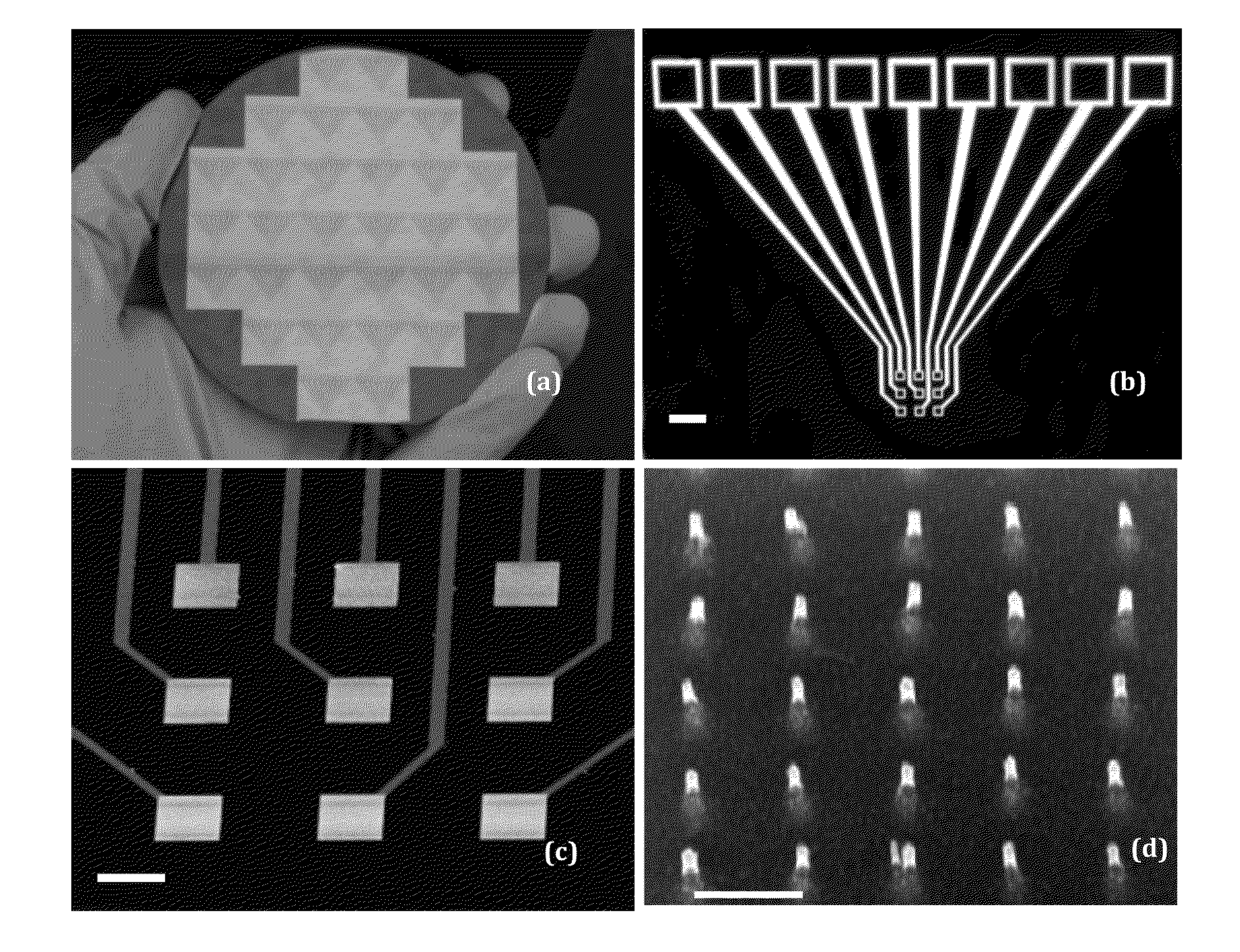Electrochemical detection of proteases using ac voltammetry on nanoelectrode arrays
a technology of ac voltammetry and proteases, which is applied in the field of electrochemical detection of proteases using ac voltammetry on nanoelectrode arrays, can solve the problems of large amount of sample and reagents, and workstation in a centralized lab is required
- Summary
- Abstract
- Description
- Claims
- Application Information
AI Technical Summary
Benefits of technology
Problems solved by technology
Method used
Image
Examples
example 1
[0049]In this Example, two types of enzymatic biosensors were prepared and tested: (1) a redox labeled ACV biosensor for protease (legumain) detection, and (2) a label-free REIS biosensor for kinase / phosphatase detection. These enzymes are critical in regulating cell behaviors, whose overexpression in human body is known to associate with various cancers. These electrochemical methods, particularly with the enhancement by NEAs, have the potential as multiplex portable techniques for rapid diagnosis or treatment monitoring of cancer patients. These two enzymatic sensors share similar fabrication techniques, but differ in the detection mechanism due to the nature of the reactions.
[0050]In the protease study, a tetrapeptide H2N—(CH2)4—CO-(SEQ ID NO:1)-NH—CH2-Fc is covalently attached to the exposed tip of a VACNF NEA as shown in FIG. 2. Fc provides reliable redox signals at 0.25 V vs. Ag / AgCl (3M KCl) in ACV measurements. As shown in later sections, the unique structure of VACNF NEA en...
example 2
[0077]In this example, the proteolytic activity of a cancer-related enzyme cathep sin B is measured with alternating current voltammetry (ACV) using ferrocene (Fc) labeled tetrapeptides attached to nanoelectrode arrays (NEAs) fabricated with vertically aligned carbon nanofibers (VACNFs).
Materials and Methods
[0078]The electrochemical measurements were conducted with an electrochemical analyzer (Model 440A, CH Instruments, Austin, Tex.). Fluorescence assay was performed on GloMax-Multi+Microplate Multimode Reader (Promega, Madison, Wis.) with black polystyrene 96 well plates obtained from Whatman (Picataway, N.J.). 3-Aminopropyl-triethoxysilane (APTES), 2-(2-methoxyethoxy)ethoxyacetic acid, 1-ethyl-3-(3-dimethylaminopropyl)carbodiimide hydrochloride (EDC), 1-hydroxy-2,5-dioxopyrrolidine-3-sulfonic acid sodium salt (sulfo-NHS), sodium hydroxide, and 6-amino-1-hexanol were purchased from Sigma-Aldrich (Saint Louis, Mo.). 2-(4-Morpholino)ethane sulfonic acid (MES) and dithiothreitol (DTT...
example 3
[0110]In this example, ACV techniques on VACNF NEAs were applied to demonstrate the possible values of cathepsin B concentrations and activities in breast cancer cell lysates and their correlation with stages of the breast cancer for the first time. The results showed that this electrochemical method has great potential as a portable multiplex system for simple and rapid protease profiling of lysate, serum or urine samples for cancer early diagnosis and treatment monitoring.
Materials
[0111]The electrochemical measurements were carried out with an electrochemical analyzer (Model 440A, CH Instruments, Austin, Tex.). Fluorescence assay was performed on GloMax-Multi+Microplate Multimode Reader (Promega, Madison, Wis.) with black polystyrene 96 well plates obtained from Whatman (Picataway, N.J.). 3-Aminopropyl-triethoxysilane (APTES), 2-(2-methoxyethoxy)ethoxyacetic acid, 1-ethyl-3-(3-dimethylaminopropyl)carbodiimide hydrochloride (EDC), 1-hydroxy-2,5-dioxopyrrolidine-3-sulfonic acid sodi...
PUM
 Login to View More
Login to View More Abstract
Description
Claims
Application Information
 Login to View More
Login to View More - R&D
- Intellectual Property
- Life Sciences
- Materials
- Tech Scout
- Unparalleled Data Quality
- Higher Quality Content
- 60% Fewer Hallucinations
Browse by: Latest US Patents, China's latest patents, Technical Efficacy Thesaurus, Application Domain, Technology Topic, Popular Technical Reports.
© 2025 PatSnap. All rights reserved.Legal|Privacy policy|Modern Slavery Act Transparency Statement|Sitemap|About US| Contact US: help@patsnap.com



